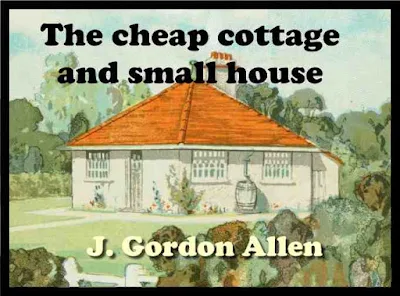The cheap cottage and small house - a manual of economical building
Review
A manual of economical building. Includes chapters on Site and Water Supply, Plan, Rooms, Exterior, Interior, Materials, Sanitation and Lighting, Prices, and Hints on Cottage Gardens. The illustrations show the exteriors of Cottages and their Plans. Housing Schemes, Workmen's and Labourers' Cottages, etc., from the latest designs.
It is a volume that should be in the hands of all architects and builders engaged in the erection of small houses, and under the housing of the Working Classes Act now operating in Ireland many small town schemes are in contemplation which requires very economically planned houses."
the book details :
Author: J. Gordon Allen Publication date 1906 Company: Letchworth, Eng. : Garden City Press Contains about 100 illustrations
The Yorkshire Post says; " Mr Allen is a man of ideas. Some of his suggestions for detached villas of about £400 or £500 each are attractive, and the £200 to £250 houses look very comfortable. There are still smaller cottages, the cost of building of which is about £100 to £110." These prices were in 1906 lol
Excerpt from the introduction
The business of housing the labourer, the smallholder and the cottager is one which is receiving increased attention. There has of late been a discussion in the press as to which is the most beautiful village in England, and none could win the palm unless aged, moss-grown and picturesque.
It is the object of Mr J. Gordon Allen, in this book, to show how we may build so that present and future generations may see beautiful villages growing up around them, that the labourer may not only be adequately housed, but that homely simplicity of construction may go hand in hand with the economy, and that the face of England may once more be dotted with homes straightforward in their construction, simple and beautiful in their design.
Simple, because need-less ornament destroys the effect of repose that the exterior needs and elaboration inside the cottage merely harbour dust.
The village has its slums no less than the town. Many a tourist who surveys from some hilltop the tower of a church nestling among the trees, the red-roofed cottages where smoke curls slowly skywards, turns away satisfied that God is in his heaven, and all is right with at least one corner of the world.
But could the same tourist only come into the village and see the low ceilings, the damp brick floors or climb the tortuous ill Ht ladders which do duty for stairs; could he then be conducted into the two tiny bedrooms which house perhaps a man and his wife, and a baker's dozen of children, such a man would turn away both sadder and wiser.
It is the business of societies such as the Rural Co-partner- ship Housing Association to arouse public interest in a deplorable state of affairs, to get at the countryfolk, help them to build and to teach the landlord how such work may be undertaken at not too great a cost.


